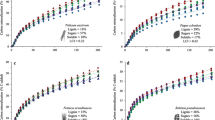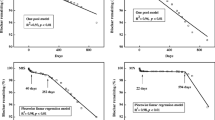Abstract
Little is known about how the structure of microbial communities impacts carbon cycling or how soil microbial community composition mediates plant effects on C-decomposition processes. We examined the degradation of four 13C-labeled compounds (starch, xylose, vanillin, and pine litter), quantified rates of associated enzyme activities, and identified microbial groups utilizing the 13C-labeled substrates in soils under oaks and in adjacent open grasslands. By quantifying increases in non-13C-labeled carbon in microbial biomarkers, we were also able to identify functional groups responsible for the metabolism of indigenous soil organic matter. Although microbial community composition differed between oak and grassland soils, the microbial groups responsible for starch, xylose, and vanillin degradation, as defined by 13C-PLFA, did not differ significantly between oak and grassland soils. Microbial groups responsible for pine litter and SOM-C degradation did differ between the two soils. Enhanced degradation of SOM resulting from substrate addition (priming) was greater in grassland soils, particularly in response to pine litter addition; under these conditions, fungal and Gram + biomarkers showed more incorporation of SOM-C than did Gram – biomarkers. In contrast, the oak soil microbial community primarily incorporated C from the added substrates. More 13C (from both simple and recalcitrant sources) was incorporated into the Gram – biomarkers than Gram + biomarkers despite the fact that the Gram + group generally comprised a greater portion of the bacterial biomass than did markers for the Gram – group. These experiments begin to identify components of the soil microbial community responsible for decomposition of different types of C-substrates. The results demonstrate that the presence of distinctly different plant communities did not alter the microbial community profile responsible for decomposition of relatively labile C-substrates but did alter the profiles of microbial communities responsible for decomposition of the more recalcitrant substrates, pine litter and indigenous soil organic matter.







Similar content being viewed by others
References
Abraham WR, Hesse C, Pelz O (1998) Ratios of carbon isotopes in microbial lipids as an indicator of substrate usage. Appl Environ Microbiol 64:4202–4209
Balser TC, Kinzig AP, Firestone MK (2002) Linking Soil microbial communities and ecosystem functioning. In: Kinzig A, Pacala S, Tilman D (eds) The functional consequences of biodiversity. Princeton University Press, Princeton, pp 265–293
Bossio DA, Scow KM (1995) Impact of carbon and flooding on the metabolic diversity of microbial communities in soils. Appl Environ Microbiol 61:4043–4050
Cheng W (1999) Rhizosphere feedbacks in elevated CO2. Tree Physiol 19:313–320
Dahlgren RA, Singer MJ, Huang X (1997) Oak tree and grazing impacts on soil properties and nutrients in a California oak woodland. Biogeochemistry (Dordrecht) 39:45–64
Deschaseaux A, Ponge JF (2001) Changes in the composition of humus profiles near the trunk base of an oak tree [ Quercus petraea (Mattus.) Liebl.]. Eur J Soil Biol 37:9–16
Eviner V (2001) Linking plant community composition and ecosystem dynamics: interactions of plant traits determine the ecosystem effects of plant species and plant species mixtures. PhD dissertation, University of California, Berkeley
Finlay BJ, Maberly SC, Cooper JI (1997) Microbial diversity and ecosystem function. Oikos. 80:209–213
Frostegård A, Bååth E (1996) The use of phospholipid fatty acid analysis to estimate bacterial and fungal biomass in soil. Biol Fertil Soils 22:59–65
Guggenberger G, Elliott ET, Frey SD, Six J, Paustian K (1999) Microbial contributions to the aggregation of a cultivated grassland soil amended with starch. Soil Biol Biochem 31:407–419
Harrison AF (1971) The inhibitory effect of oak leaf litter tannins on the growth of fungi, in relation to litter decomposition. Soil Biol Biochem 3:167–172
Herman DJ, Halverson LJ, Firestone MK (2003) Nitrogen dynamics in a Mediterranean annual grassland: effects of oak canopies and tree removal, climatic variables, and microbial populations. Ecol Appl (in press)
Houston APC, Visser S, Lautenschlager RA (1998) Response of microbial processes and fungal community structure to vegetation management in mixed-wood forest soils. Can J Bot 76:2002–2010
Jackson LE, Strauss RB, Firestone MK, Bartolome JW (1990) Influence of tree canopies on grassland productivity and nitrogen dynamics in deciduous oak savanna. Agric Ecosyst Environ 32:89–105
Kuske CR, Ticknor LO, Miller ME, Dunbar JM, Davis JA, Barns SM, Belnap J (2002) Comparison of soil bacterial communities in rhizospheres of three plant species and the interspaces in an arid grassland. Appl Environ Microbiol 68:1854–1863
Kuzyakov Y, Friedel JK, Stahr K (2000) Review of mechanisms and quantification of priming effects. Soil Biol Biochem 32:1485–1498
Lopez Llorca LV, Olivares Bernabeu C (1997) Growth inhibition of nematophagous and entomopathogenic fungi by leaf litter and soil containing phenols. Mycol Res 101:691–697
Madigan MT, Martinko JM, Parker J (2003) Brock biology of microorganisms. Prentice Hall, New Jersey
Myers RT, Zak DR, White DC, Peacock A (2001) Landscape-level patterns of microbial community composition and substrate in upland forest ecosystems. Soil Sci Soc Am J 65:359–367
Page AL, Miller RH, Keeney DR (eds) (1982) Methods of soil analysis, Part 2. ASA, Madison, Wis.
Phillips RL, Zak DR, Holmes WE, White DC (2002) Microbial community composition and function beneath temperate trees exposed to elevated atmospheric carbon dioxide and ozone. Oecologia 131:236–244
Schimel JP, Gulledge J (1998) Microbial community structure and global trace gases. Global Change Biol 4:745–758
Stark JM, Firestone MK (1996) Kinetic characteristics of ammonium-oxidizer communities in a California oak woodland-annual grassland. Soil Biol Biochem 28:1307–1317
Wall DH, Moore JC (1999) Interactions underground: soil biodiversity, mutualism, and ecosystem processes. Bioscience 49:109–117
Westover KM, Kennedy AC, Kelley SE (1997) Patterns of rhizosphere microbial community structure associated with co-occurring plant species. J Ecol 85:863–873
White DC, Ringelberg DB (1998) Signature lipid biomarker analysis. In: Burlage RS, Atlas R, Stahl D, Geesey G, Sayler G (ed) Techniques in microbial ecology. Oxford University Press, New York, pp 255–272
Zogg GP, Zak DR, Ringelberg DB, MacDonald NW, Pregitzer KS, White DC (1997) Compositional and functional shifts in microbial communities due to soil warming. Soil Sci Soc Am J 61:475–481
Acknowledgements
The authors acknowledge financial support from the Kearney Foundation for Soil Science Research, California AES project 6117-H, and the Hopland Research and Extension Center. Don Herman, Paul Brooks, Bill Holmes, and Tamas Torok provided laboratory assistance and Don Zak provided valuable comments on the manuscript.
Author information
Authors and Affiliations
Corresponding author
Rights and permissions
About this article
Cite this article
Waldrop, M.P., Firestone, M.K. Microbial community utilization of recalcitrant and simple carbon compounds: impact of oak-woodland plant communities. Oecologia 138, 275–284 (2004). https://doi.org/10.1007/s00442-003-1419-9
Received:
Accepted:
Published:
Issue Date:
DOI: https://doi.org/10.1007/s00442-003-1419-9




